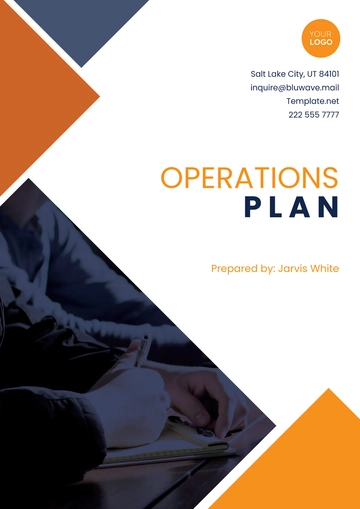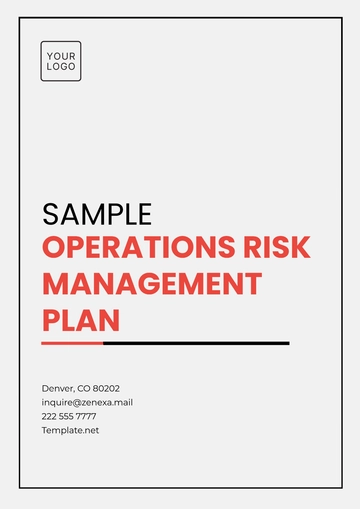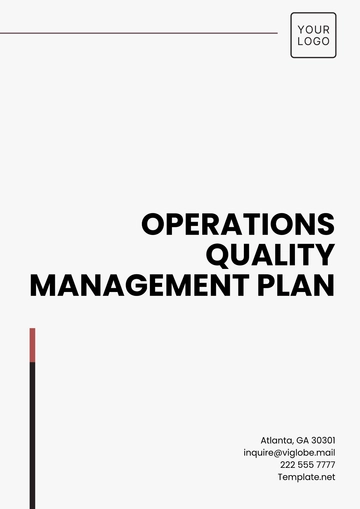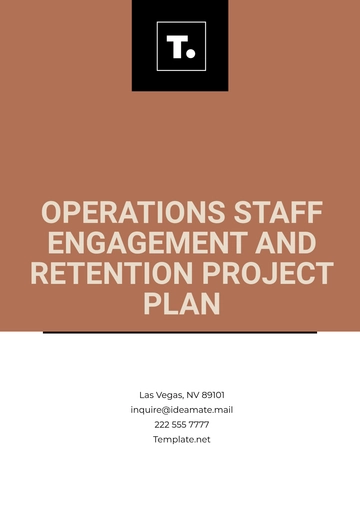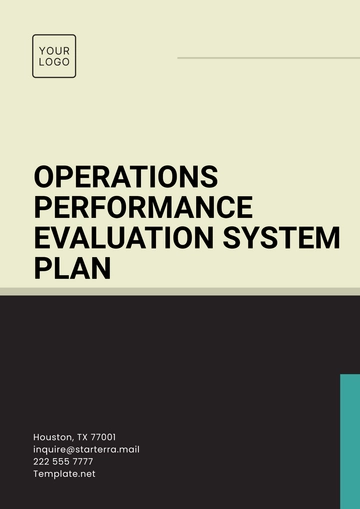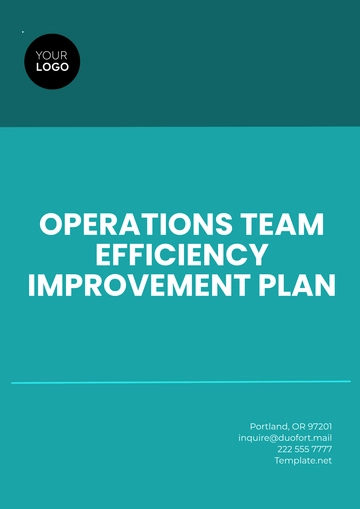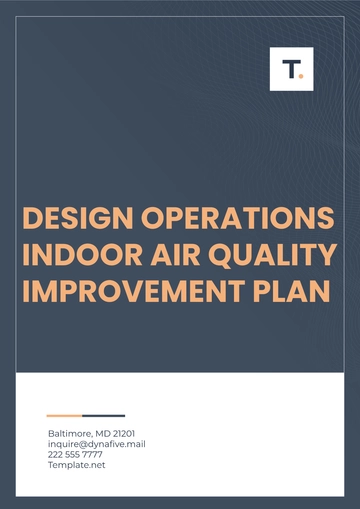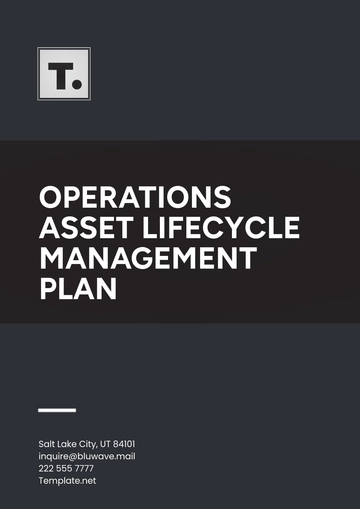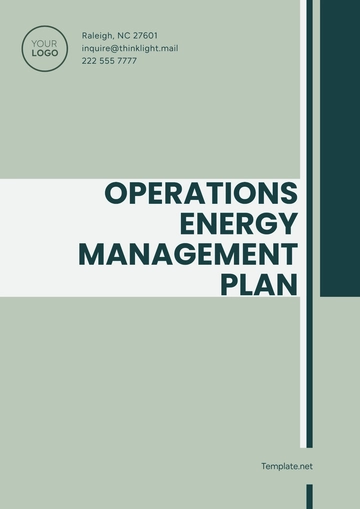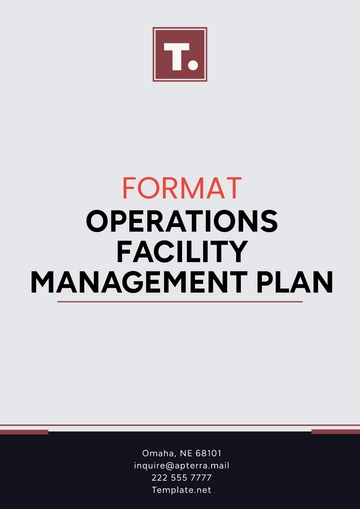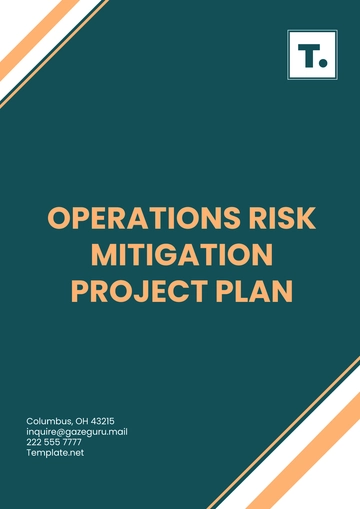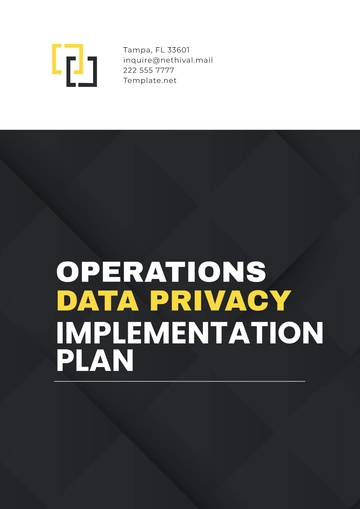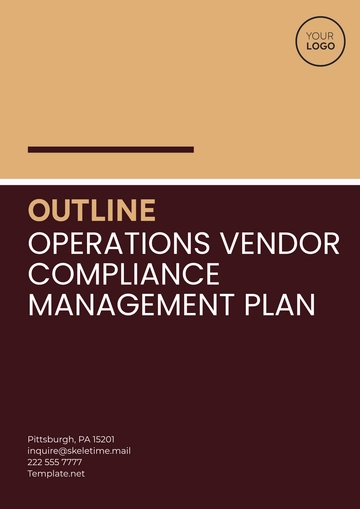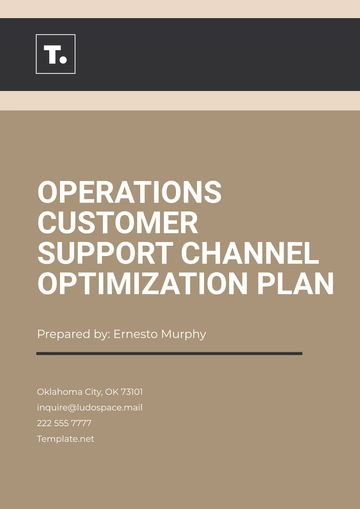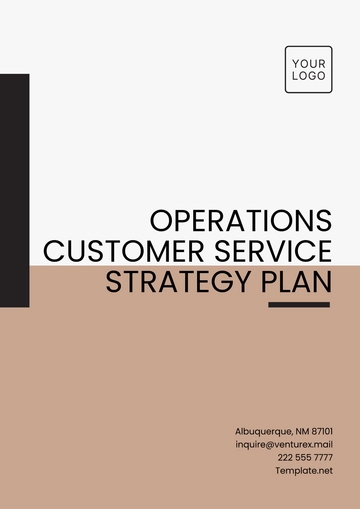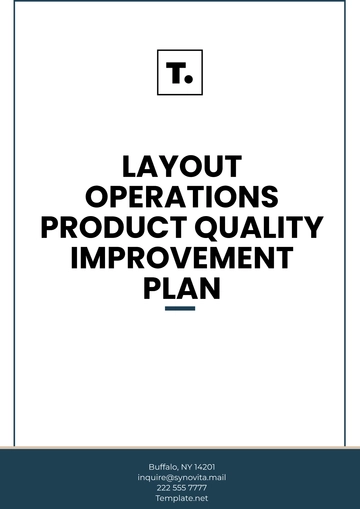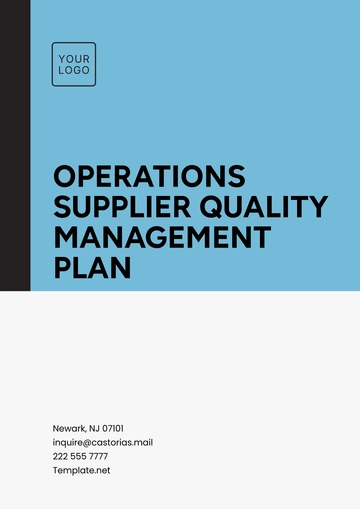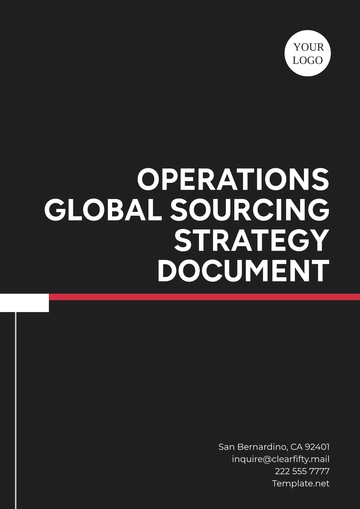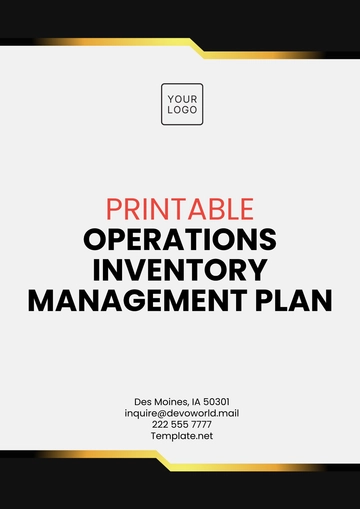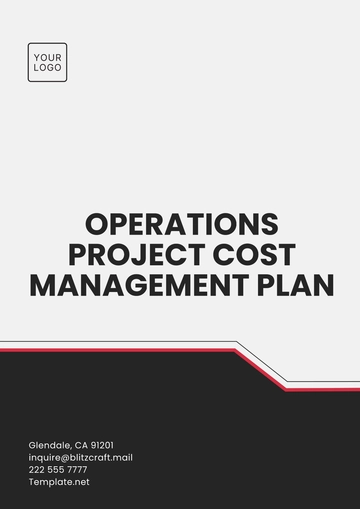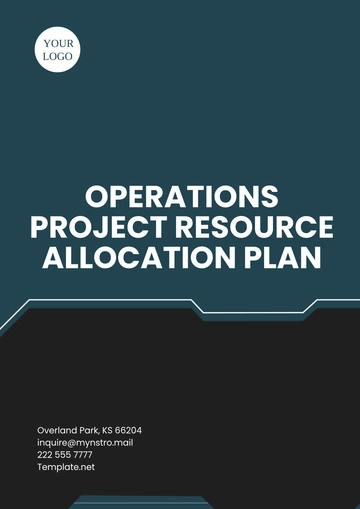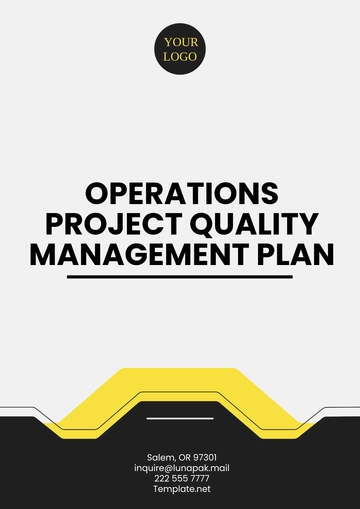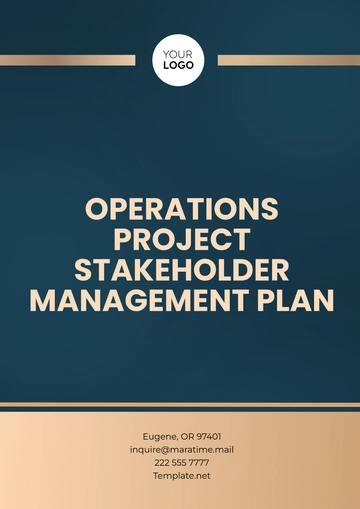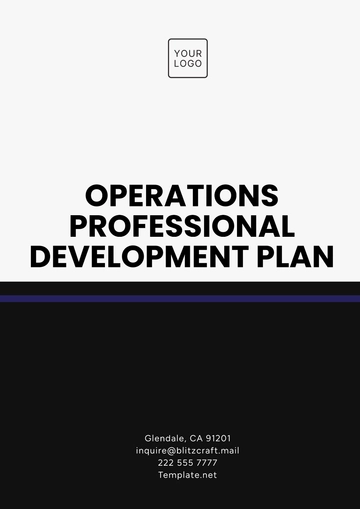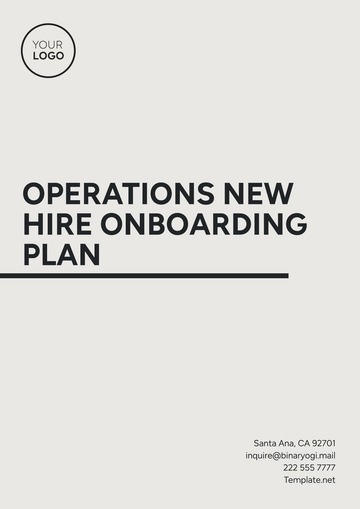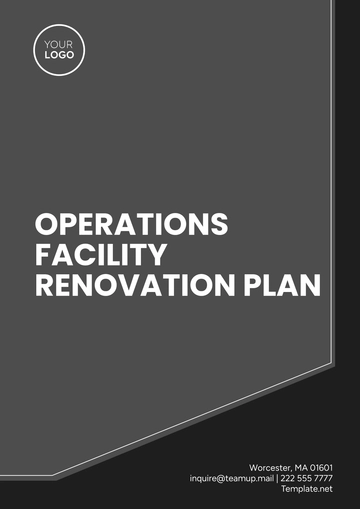Free Car Rental Operational Plan
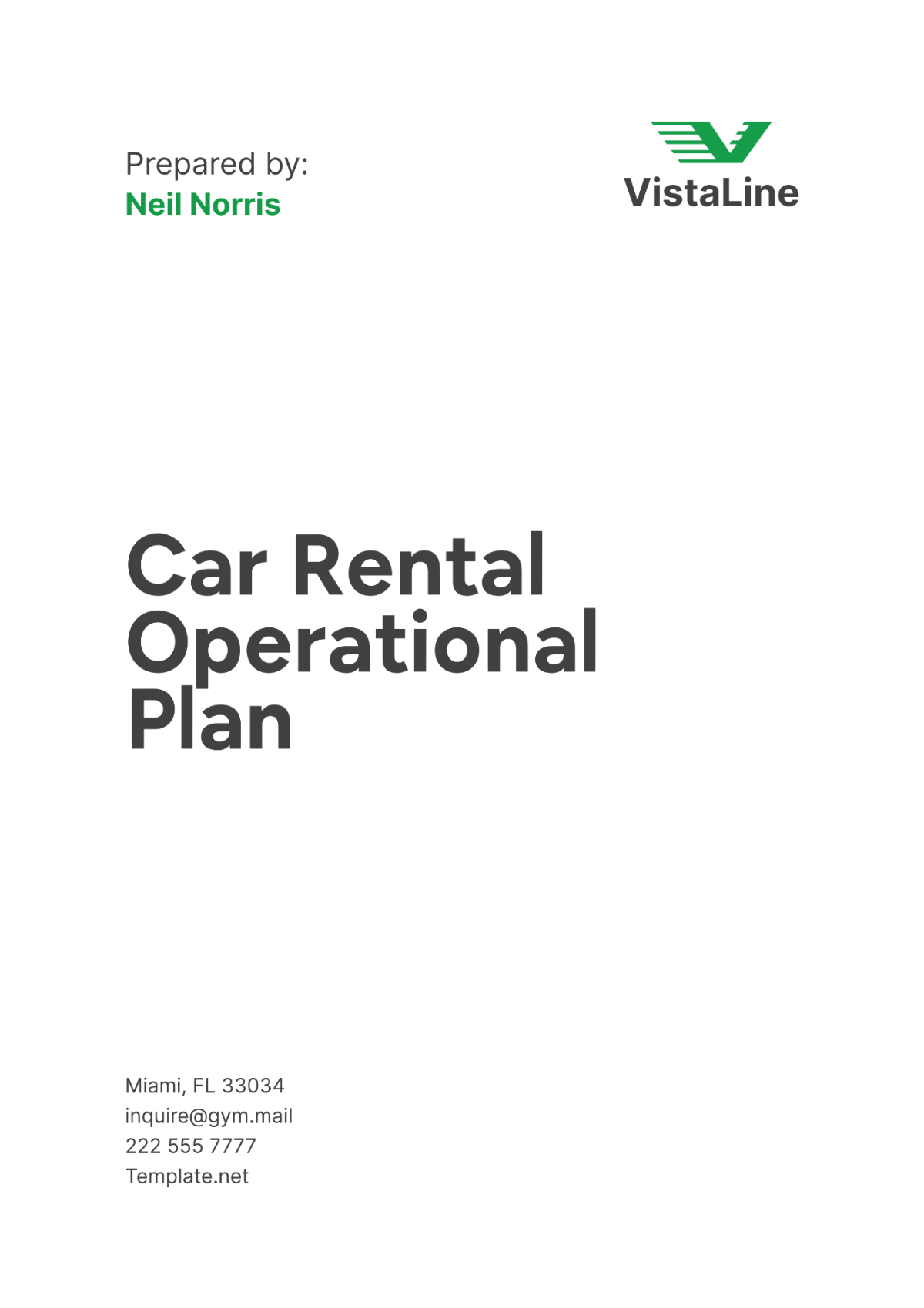
I. Executive Summary
[Your Company Name] is a leading car rental business committed to providing exceptional service, high-quality vehicles, and competitive pricing. This operational plan outlines the key strategies, processes, and financial goals for the upcoming year to ensure continued growth and customer satisfaction.
The financial projections for the year 2055 indicate a target revenue of $10,000,000, with an expected profit margin of 15%. To achieve these goals, the company will focus on optimizing fleet management, enhancing customer service, and implementing effective marketing strategies. Additionally, cost management initiatives will be implemented to ensure operational efficiency and profitability.
By following this operational plan, [Your Company Name] aims to strengthen its market position, attract new customers, and retain existing ones. The plan outlines specific actions and measurable targets to guide the company's operations and drive sustainable growth.
II. Fleet Management
A. Fleet Acquisition
Vehicle Selection: Carefully select vehicles that meet customer preferences and market demand. Focus on acquiring a diverse range of vehicles, including economy, luxury, and eco-friendly options.
Supplier Relationships: Establish strong relationships with vehicle suppliers to secure favorable pricing and terms. Regularly review supplier performance and negotiate contracts to ensure the best deals.
Budget Allocation: Allocate a budget of $3,000,000 for vehicle acquisition. Ensure the budget is distributed to balance between new acquisitions and fleet replacement.
Market Analysis: Conduct regular market analysis to identify emerging trends and adjust the fleet composition accordingly. This helps in meeting customer expectations and staying competitive.
Lifecycle Management: Implement a vehicle lifecycle management program to optimize the timing of purchases and disposals. Regularly update the fleet to maintain quality and reduce maintenance costs.
B. Maintenance and Repairs
Preventive Maintenance: Establish a preventive maintenance schedule to minimize breakdowns and extend vehicle lifespan. Regularly service vehicles based on mileage and usage patterns.
Maintenance Partnerships: Partner with reliable service providers to ensure high-quality maintenance and repair services. Negotiate bulk service agreements for cost efficiency.
Tracking System: Implement a fleet management system to track maintenance schedules, service history, and repair costs. This system will provide real-time data for better decision-making.
Cost Management: Monitor and control maintenance costs by reviewing expenses regularly. Identify areas for cost reduction without compromising service quality.
Customer Feedback: Use customer feedback to identify common maintenance issues and address them promptly. Ensure vehicles are in top condition to enhance customer satisfaction.
III. Customer Service
A. Training and Development
Staff Training: Develop comprehensive training programs for customer service staff. Focus on improving communication skills, problem-solving abilities, and product knowledge.
Ongoing Education: Provide ongoing education and professional development opportunities for staff. This includes workshops, seminars, and online courses.
Performance Metrics: Establish performance metrics to evaluate staff effectiveness. Use customer feedback and satisfaction surveys to measure performance and identify areas for improvement.
Incentive Programs: Implement incentive programs to reward outstanding customer service. This can include bonuses, recognition awards, and career advancement opportunities.
Feedback Loop: Create a feedback loop where staff can provide input on customer service processes and suggest improvements. Regularly review and act on this feedback.
B. Customer Feedback Mechanisms
Surveys and Reviews: Regularly conduct customer satisfaction surveys and encourage online reviews. Use this feedback to identify strengths and areas for improvement.
Complaint Resolution: Establish a clear and efficient complaint resolution process. Ensure all customer complaints are addressed promptly and satisfactorily.
Loyalty Programs: Implement loyalty programs to reward repeat customers. Offer benefits such as discounts, free upgrades, and exclusive offers.
Personalized Services: Provide personalized services based on customer preferences and past rental history. Use customer data to tailor offers and communications.
Customer Support: Enhance customer support channels, including phone, email, and live chat. Ensure customers can easily reach support for assistance.
IV. Marketing and Sales
A. Marketing Strategies
Digital Marketing: Invest in digital marketing strategies, including search engine optimization (SEO), pay-per-click (PPC) advertising, and social media marketing. Allocate a budget of $500,000 for these initiatives.
Content Marketing: Develop high-quality content to engage and inform customers. This includes blog posts, videos, and social media content. Focus on topics such as travel tips, vehicle maintenance, and rental guides.
Email Campaigns: Implement targeted email campaigns to nurture leads and retain customers. Use customer data to personalize messages and offers.
Partnerships: Form partnerships with travel agencies, hotels, and airlines to expand reach and offer bundled services. Negotiate mutually beneficial agreements to drive referrals.
Brand Awareness: Increase brand awareness through public relations efforts, sponsorships, and community involvement. Participate in local events and support charitable initiatives.
B. Sales Strategies
Sales Training: Provide regular training for sales staff to improve their skills and product knowledge. Focus on upselling and cross-selling techniques.
Lead Generation: Implement lead generation strategies to attract new customers. Use digital marketing, referrals, and partnerships to generate leads.
Customer Retention: Focus on customer retention by providing excellent service and personalized offers. Implement loyalty programs and regular follow-ups.
Performance Metrics: Establish sales performance metrics and regularly review progress. Use data to identify trends and adjust strategies accordingly.
Sales Tools: Provide sales staff with the necessary tools and resources to succeed. This includes customer relationship management (CRM) systems, marketing materials, and sales training programs.
V. Financial Management
A. Budgeting and Forecasting
The following chart and table present the budget allocation for key operational areas:
Operational Area | Budget Allocation |
|---|---|
Fleet Acquisition | $3,000,000 |
Marketing | $500,000 |
Customer Service | $200,000 |
Maintenance and Repairs | $800,000 |
Staff Training | $100,000 |
Miscellaneous Expenses | $400,000 |
Total | $5,000,000 |
Fleet Acquisition: Allocating $3,000,000 for fleet acquisition ensures that [Your Company Name] can maintain a diverse and high-quality vehicle selection. This budget supports both new purchases and fleet replacements, crucial for meeting customer demands and maintaining service quality.
Marketing: The $500,000 marketing budget is dedicated to digital marketing, content creation, and partnership initiatives. This investment aims to increase brand awareness, attract new customers, and retain existing ones through targeted campaigns and promotions.
Customer Service: Allocating $200,000 to customer service initiatives supports training programs, customer feedback mechanisms, and incentive programs. This investment ensures that staff are well-equipped to provide excellent service and enhance customer satisfaction.
Maintenance and Repairs: With $800,000 allocated for maintenance and repairs, [Your Company Name] can ensure vehicles are well-maintained and reliable. This budget covers preventive maintenance, repair costs, and partnerships with service providers.
Staff Training: The $100,000 budget for staff training supports comprehensive training and development programs. Continuous education and professional development are essential for maintaining high service standards and staff performance.
Miscellaneous Expenses: A $400,000 budget for miscellaneous expenses provides flexibility to cover unforeseen costs and additional operational needs. This ensures that the company can adapt to changing circumstances and maintain operational efficiency.
Effective financial management is crucial for the success of [Your Company Name]. By allocating budgets strategically and monitoring expenses, the company can achieve its financial goals and sustain growth.
B. Revenue and Profit Projections
The following table presents the projected revenue and profit for the upcoming year:
Metric | Amount |
|---|---|
Total Revenue | $10,000,000 |
Operating Expenses | $8,500,000 |
Net Profit | $1,500,000 |
Profit Margin | 15% |
Total Revenue: The projected total revenue of $10,000,000 reflects the expected income from vehicle rentals and related services. Achieving this target requires effective marketing, sales strategies, and customer retention efforts.
Operating Expenses: Operating expenses are projected to be $8,500,000, covering fleet acquisition, marketing, customer service, maintenance, and other operational costs. Efficient cost management is essential to maintain profitability.
Net Profit: The net profit of $1,500,000 indicates the company's ability to generate profit after covering all operating expenses. A 15% profit margin is a positive indicator of financial health and operational efficiency.
Profit Margin: A profit margin of 15% demonstrates that [Your Company Name] is effectively managing costs and generating sufficient revenue to sustain profitability. Continuous monitoring and optimization of expenses will help maintain and improve this margin.
Achieving the projected revenue and profit targets requires a comprehensive approach to financial management. By focusing on revenue growth and cost control, [Your Company Name] can ensure long-term financial stability and success.
VI. Technology and Innovation
A. Fleet Management Systems
Telematics: Implement telematics systems to monitor vehicle health, usage, and location in real-time. This technology helps optimize maintenance schedules, improve fuel efficiency, and enhance fleet security.
GPS Tracking: Use GPS tracking to manage vehicle locations and improve logistics. This system enhances route planning, reduces downtime, and improves customer service by providing accurate delivery times.
Fleet Management Software: Invest in fleet management software to centralize data and streamline operations. This software provides insights into vehicle performance, maintenance schedules, and operational costs.
Automated Reporting: Implement automated reporting tools to generate real-time reports on fleet performance, maintenance costs, and other key metrics. This enables data-driven decision-making and operational efficiency.
Mobile Applications: Develop mobile applications for customers and staff to improve communication and service delivery. These apps can facilitate bookings, provide real-time updates, and enhance customer engagement.
B. Customer Relationship Management (CRM) Systems
Customer Data: Implement a CRM system to centralize and manage customer data. This system helps track customer interactions, preferences, and feedback for personalized service.
Automated Marketing: Use CRM tools to automate marketing campaigns and customer communications. Personalized emails, promotions, and follow-ups can enhance customer engagement and retention.
Sales Tracking: Track sales performance and customer conversions using the CRM system. This data helps identify trends, measure campaign effectiveness, and adjust strategies accordingly.
Customer Support: Integrate customer support features into the CRM system to streamline issue resolution. This includes ticketing systems, live chat, and automated responses.
Analytics: Use CRM analytics to gain insights into customer behavior and preferences. This data-driven approach helps tailor services and marketing efforts to meet customer needs.
C. Website and Online Booking System
User Experience: Revamp the website to enhance user experience and navigation. Ensure the site is mobile-friendly and provides a seamless booking process.
Real-Time Availability: Integrate real-time vehicle availability into the booking system. This transparency helps prevent overbooking and enhances customer trust.
Payment Options: Offer multiple payment options, including credit cards, digital wallets, and installment plans. Providing flexibility in payment methods improves customer convenience.
Security: Implement robust security measures to protect customer data and transactions. Ensure compliance with data protection regulations and industry standards.
Feedback Integration: Integrate customer feedback mechanisms into the website. This includes post-rental surveys and review prompts to gather valuable insights and improve services.
VII. Human Resources
A. Recruitment and Staffing
Talent Acquisition: Develop a strategic recruitment plan to attract top talent. Focus on hiring individuals with relevant experience, skills, and a customer-centric mindset.
Job Descriptions: Create clear and detailed job descriptions to attract suitable candidates. Ensure the descriptions outline key responsibilities, qualifications, and expectations.
Interview Process: Implement a structured interview process to assess candidate suitability. Use a combination of behavioral and technical questions to evaluate skills and cultural fit.
Onboarding: Develop a comprehensive onboarding program to integrate new hires into the company. This includes orientation sessions, training programs, and mentorship opportunities.
Diversity and Inclusion: Promote diversity and inclusion in the hiring process. Ensure equal opportunities for all candidates and foster an inclusive work environment.
B. Employee Training and Development
Training Programs: Develop training programs to enhance employee skills and knowledge. Focus on customer service, product knowledge, and operational procedures.
Professional Development: Offer professional development opportunities, including workshops, seminars, and online courses. Encourage employees to pursue certifications and advanced training.
Performance Reviews: Conduct regular performance reviews to assess employee progress and identify areas for improvement. Provide constructive feedback and set clear performance goals.
Career Advancement: Create career advancement opportunities for employees. Develop clear career paths and provide support for promotions and role changes.
Employee Engagement: Implement initiatives to boost employee engagement and satisfaction. This includes team-building activities, recognition programs, and wellness initiatives.
VIII. Risk Management
A. Risk Identification and Assessment
Operational Risks: Identify and assess operational risks, including vehicle breakdowns, accidents, and service disruptions. Develop contingency plans to mitigate these risks.
Financial Risks: Monitor financial risks, such as cash flow issues, credit risks, and economic downturns. Implement strategies to manage and mitigate financial risks.
Regulatory Risks: Stay updated on regulatory changes and compliance requirements. Ensure all operations adhere to local, state, and federal regulations.
Cybersecurity Risks: Identify and address cybersecurity risks, including data breaches and cyber-attacks. Implement robust security measures to protect sensitive information.
Reputation Risks: Monitor and manage reputation risks, such as negative customer feedback and public relations issues. Develop strategies to address and mitigate these risks.
B. Risk Mitigation Strategies
Insurance Coverage: Ensure comprehensive insurance coverage for all vehicles and operations. Regularly review and update insurance policies to address changing risks.
Emergency Response: Develop and implement an emergency response plan for incidents such as accidents, natural disasters, and service disruptions. Conduct regular drills and training.
Data Security: Implement advanced data security measures to protect against cyber threats. This includes encryption, firewalls, and regular security audits.
Regulatory Compliance: Establish a compliance program to monitor and ensure adherence to all regulatory requirements. Conduct regular audits and training sessions.
Customer Communication: Develop a clear communication strategy to address customer concerns and feedback. Ensure timely and transparent communication in case of service disruptions or issues.
IX. Conclusion and Next Steps
A. Conclusion
The Operational Plan of [Your Company Name] outlines a comprehensive strategy to achieve business objectives and ensure operational excellence for the year 2055. By focusing on key areas such as fleet management, customer service, marketing, financial management, technology, human resources, and risk management, the company is well-positioned to meet customer expectations and drive growth.
Implementing the strategies and initiatives detailed in this plan will enhance customer satisfaction, optimize operational efficiency, and improve financial performance. Continuous monitoring and adaptation of these strategies will ensure the company remains competitive in the dynamic car rental industry.
B. Next Steps
The following steps outline the immediate actions to implement the operational plan:
Finalize Budget Allocation: Review and finalize the budget allocations for key operational areas. Ensure all departments are aware of their budgets and financial targets.
Initiate Fleet Acquisition: Begin the process of acquiring new vehicles and updating the fleet. Establish supplier contracts and negotiate favorable terms.
Launch Training Programs: Develop and launch comprehensive training programs for customer service and sales staff. Schedule regular training sessions and workshops.
Enhance Digital Marketing: Implement digital marketing strategies and campaigns. Allocate resources for SEO, PPC, and social media marketing initiatives.
Implement CRM System: Deploy the CRM system and train staff on its use. Begin integrating customer data and automating marketing campaigns.
Monitor Performance Metrics: Establish performance metrics for all key areas. Regularly review progress and adjust strategies as needed.
By following these next steps, [Your Company Name] can ensure the successful implementation of the operational plan and achieve its business goals. Continuous improvement and adaptation will drive long-term success and customer satisfaction.
- 100% Customizable, free editor
- Access 1 Million+ Templates, photo’s & graphics
- Download or share as a template
- Click and replace photos, graphics, text, backgrounds
- Resize, crop, AI write & more
- Access advanced editor
Optimize operations with the Car Rental Operational Plan Template available on Template.net! This editable template helps you outline your operational strategies and goals. The customizable format allows for adjustments to fit your business needs. Use the AI Editor Tool to create an effective and detailed operational plan that drives success!
You may also like
- Finance Plan
- Construction Plan
- Sales Plan
- Development Plan
- Career Plan
- Budget Plan
- HR Plan
- Education Plan
- Transition Plan
- Work Plan
- Training Plan
- Communication Plan
- Operation Plan
- Health And Safety Plan
- Strategy Plan
- Professional Development Plan
- Advertising Plan
- Risk Management Plan
- Restaurant Plan
- School Plan
- Nursing Home Patient Care Plan
- Nursing Care Plan
- Plan Event
- Startup Plan
- Social Media Plan
- Staffing Plan
- Annual Plan
- Content Plan
- Payment Plan
- Implementation Plan
- Hotel Plan
- Workout Plan
- Accounting Plan
- Campaign Plan
- Essay Plan
- 30 60 90 Day Plan
- Research Plan
- Recruitment Plan
- 90 Day Plan
- Quarterly Plan
- Emergency Plan
- 5 Year Plan
- Gym Plan
- Personal Plan
- IT and Software Plan
- Treatment Plan
- Real Estate Plan
- Law Firm Plan
- Healthcare Plan
- Improvement Plan
- Media Plan
- 5 Year Business Plan
- Learning Plan
- Marketing Campaign Plan
- Travel Agency Plan
- Cleaning Services Plan
- Interior Design Plan
- Performance Plan
- PR Plan
- Birth Plan
- Life Plan
- SEO Plan
- Disaster Recovery Plan
- Continuity Plan
- Launch Plan
- Legal Plan
- Behavior Plan
- Performance Improvement Plan
- Salon Plan
- Security Plan
- Security Management Plan
- Employee Development Plan
- Quality Plan
- Service Improvement Plan
- Growth Plan
- Incident Response Plan
- Basketball Plan
- Emergency Action Plan
- Product Launch Plan
- Spa Plan
- Employee Training Plan
- Data Analysis Plan
- Employee Action Plan
- Territory Plan
- Audit Plan
- Classroom Plan
- Activity Plan
- Parenting Plan
- Care Plan
- Project Execution Plan
- Exercise Plan
- Internship Plan
- Software Development Plan
- Continuous Improvement Plan
- Leave Plan
- 90 Day Sales Plan
- Advertising Agency Plan
- Employee Transition Plan
- Smart Action Plan
- Workplace Safety Plan
- Behavior Change Plan
- Contingency Plan
- Continuity of Operations Plan
- Health Plan
- Quality Control Plan
- Self Plan
- Sports Development Plan
- Change Management Plan
- Ecommerce Plan
- Personal Financial Plan
- Process Improvement Plan
- 30-60-90 Day Sales Plan
- Crisis Management Plan
- Engagement Plan
- Execution Plan
- Pandemic Plan
- Quality Assurance Plan
- Service Continuity Plan
- Agile Project Plan
- Fundraising Plan
- Job Transition Plan
- Asset Maintenance Plan
- Maintenance Plan
- Software Test Plan
- Staff Training and Development Plan
- 3 Year Plan
- Brand Activation Plan
- Release Plan
- Resource Plan
- Risk Mitigation Plan
- Teacher Plan
- 30 60 90 Day Plan for New Manager
- Food Safety Plan
- Food Truck Plan
- Hiring Plan
- Quality Management Plan
- Wellness Plan
- Behavior Intervention Plan
- Bonus Plan
- Investment Plan
- Maternity Leave Plan
- Pandemic Response Plan
- Succession Planning
- Coaching Plan
- Configuration Management Plan
- Remote Work Plan
- Self Care Plan
- Teaching Plan
- 100-Day Plan
- HACCP Plan
- Student Plan
- Sustainability Plan
- 30 60 90 Day Plan for Interview
- Access Plan
- Site Specific Safety Plan
